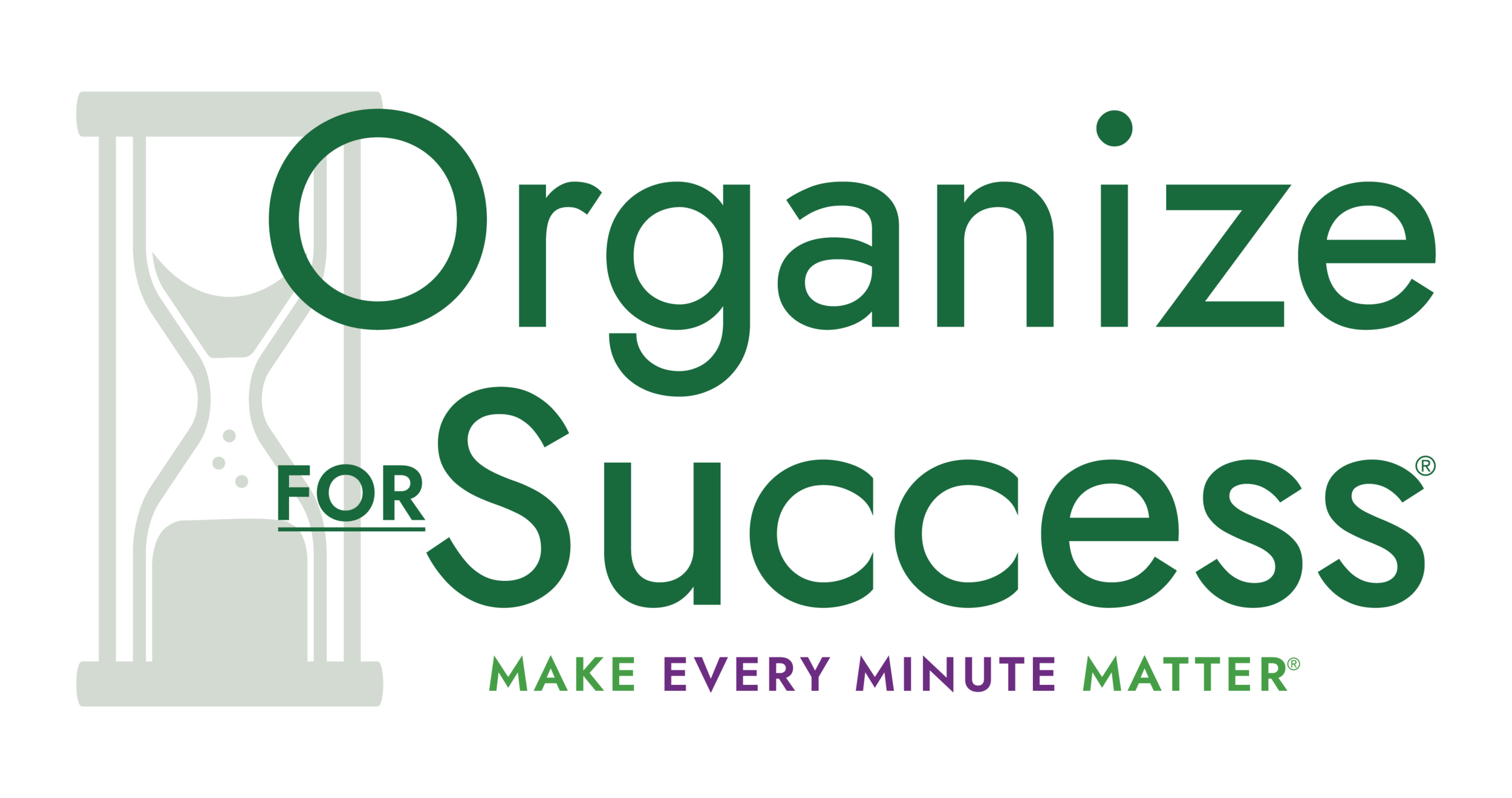Put Your ADHD To Work for Greater Productivity
Attention Deficit Hyperactivity Disorder (or ADHD) results from an imbalance of chemical messengers or neurotransmitters within your brain, and it's definitely real. ADHD is a breakdown of the communication networks between regions of the brain that control arousal, emotion, attention and behavior. This ADHD Awareness Month is the ideal time to share facts and best practices for utilizing your ADHD as a tool to organize for success.
ADHD is sometimes mistakenly believed to affect only children with others claiming, "they'll grow out of it." Yet, it often gets worse with age, putting adults with ADHD at risk of stigma even as it's protected under the Americans with Disabilities Act. Be mindful of its continued impact throughout life.
⠀
As ADHD can present in any of these three manners, it's particularly difficult to diagnose:
✔️ Inattentive
✔️ Hyperactive-impulsive
✔️ Combined inattentive & hyperactive-impulsive.
⠀
Recognize that ADHD is a brain-based disorder with symptoms linked to many specific brain areas, and, although it lasts a lifetime, it is treatable.
This common, non-discriminatory disorder does not make one unable to do assigned work; instead, 𝗔𝗗𝗛𝗗 𝗺𝗮𝗸𝗲𝘀 𝗶𝘁 𝗵𝗮𝗿𝗱𝗲𝗿 𝗳𝗼𝗿 𝘁𝗵𝗼𝘀𝗲 𝘄𝗵𝗼 𝗵𝗮𝘃𝗲 𝗶𝘁 𝘁𝗼 𝗱𝗼 𝘄𝗼𝗿𝗸 𝗶𝗻 𝘄𝗮𝘆𝘀 𝘁𝗵𝗮𝘁 𝗹𝗼𝗼𝗸 𝗹𝗶𝗸𝗲 𝗵𝗼𝘄 𝗼𝘁𝗵𝗲𝗿𝘀 𝗱𝗼 𝘁𝗵𝗲𝗶𝗿 𝘄𝗼𝗿𝗸, greatly impacting #productivity. Although it's difficult to diagnose, treatment for ADHD can be life-changing, involving medication, psychotherapy, behavioral interventions, education or training and educational support.
⠀
Particularly for adult women, ADHD often manifests as overwhelm with tedious, repetitive tasks proving especially challenging. Yet, amidst all these challenges, ADHD women often feel like they "should" be able to do “all the things” because they see so many others seemingly successfully juggling everything, which is unrealistic and leads to low self-esteem. Many bright, capable women with ADHD think they're lazy, incompetent or simply not good enough, and that's simply not the case. Let go of the guilt or need to do it all; focus on what you must do.
⠀
By strategically and proactively delegating these, you'll have more time, energy and focus for what matters most, addressing what moves you forward and best utilizing your unique skill set.
As you focus on that which must be done by only you, consider delegating in these two instances where delegation is often most helpful:
👩🏻💻 Instances in which the task that needs to be completed can be done as well as or better than you can do it;
🗓 Instances in which you've procrastinated and keep moving the due date forward such that it's more and more obvious you will not get it done yourself.
⠀
Then, when moving forward with those tasks which must be done by you, consider a visual to-do list. Research shows that 𝘄𝗲 𝗶𝗻𝘁𝗲𝗿𝗽𝗿𝗲𝘁 𝗮𝗻𝗱 𝗿𝗲𝗰𝗮𝗹𝗹 𝗶𝗺𝗮𝗴𝗲𝘀 𝗺𝗼𝗿𝗲 𝗾𝘂𝗶𝗰𝗸𝗹𝘆 𝘁𝗵𝗮𝗻 𝘁𝗲𝘅𝘁 𝗯𝗲𝗰𝗮𝘂𝘀𝗲 𝘁𝗲𝘅𝘁 𝗿𝗲𝗾𝘂𝗶𝗿𝗲𝘀 𝘁𝗶𝗺𝗲 𝘁𝗼 𝗽𝗿𝗼𝗰𝗲𝘀𝘀 𝘁𝗵𝗲 𝗱𝗲𝘀𝗶𝗿𝗲𝗱 𝗺𝗲𝘀𝘀𝗮𝗴𝗲. There are plenty of task-related stickers available, like from Simplified by Emily Ley, Cultivate What Matters or a search of "calendar stickers" on Amazon; alternatively, you could draw a picture for each action that needs to get done, like what you may have seen via some versions of dot journaling. Any of these options for incorporating visuals into task management can make an immediate, positive impact on boosting productivity.
When working through your visual to-do list, keep in mind that time is your most limited resource and being aware of what time you have can be imperative for your success. As a critical executive function, a good sense of time involves knowing what time it is, how much time is left in something or before the next commitment and how quickly time is passing. Folks with ADHD are often what's called "time blind", meaning they are less aware of the passage of time and frequently struggle to use time effectively, impacting productivity.
⠀
To boost your sense of time this ADHD Awareness Month, consider these action items:
⏱ 𝗠𝗮𝗸𝗲 𝗻𝗼𝘁𝗲 𝗼𝗳 𝘄𝗵𝗶𝗰𝗵 𝗮𝗰𝘁𝗶𝘃𝗶𝘁𝗶𝗲𝘀 𝗺𝗼𝗿𝗲 𝗼𝗳𝘁𝗲𝗻 𝗹𝗲𝗮𝗱 𝘁𝗼 𝘆𝗼𝘂𝗿 𝗹𝗼𝘀𝗶𝗻𝗴 𝘁𝗿𝗮𝗰𝗸 𝗼𝗳 𝘁𝗶𝗺𝗲. Are there instances in which you should avoid those activities? Would a timer put boundaries on your engagement in those time-stealing activities?
🎶 𝗖𝗼𝗻𝘀𝗶𝗱𝗲𝗿 𝗰𝗿𝗮𝗳𝘁𝗶𝗻𝗴 𝗽𝗹𝗮𝘆𝗹𝗶𝘀𝘁𝘀 𝗮𝘀𝘀𝗶𝗴𝗻𝗲𝗱 𝘁𝗼 𝗰𝗲𝗿𝘁𝗮𝗶𝗻 𝗿𝗼𝘂𝘁𝗶𝗻𝗲𝘀 𝗼𝗿 𝗯𝗹𝗼𝗰𝗸𝘀 𝗼𝗳 𝘁𝗶𝗺𝗲 𝘁𝗼 𝗸𝗲𝗲𝗽 𝘆𝗼𝘂 𝗼𝗻 𝘁𝗿𝗮𝗰𝗸. For example, maybe you create a playlist that's the length of time you allocate for your morning routine or that's long enough to fill the 25-minute work block in the Pomodoro Technique.
🕙 𝗥𝗲𝗽𝗹𝗮𝗰𝗲 𝗲𝗮𝗰𝗵 𝗱𝗶𝗴𝗶𝘁𝗮𝗹 𝗰𝗹𝗼𝗰𝗸 𝘄𝗶𝘁𝗵 𝗮𝗻 𝗮𝗻𝗮𝗹𝗼𝗴 𝗼𝗻𝗲 so you can see the hands moving and, thereby, see time visually disappearing, similar to how the Time Timer functions.
⏳ Rather than being overwhelmed by an entire project, 𝗯𝗿𝗲𝗮𝗸 𝗲𝗮𝗰𝗵 𝗽𝗿𝗼𝗷𝗲𝗰𝘁 𝗶𝗻𝘁𝗼 𝘁𝗶𝗻𝘆, 𝗮𝗰𝘁𝗶𝗼𝗻𝗮𝗯𝗹𝗲 𝘀𝘁𝗲𝗽𝘀, starting each with a verb, assigning deadlines to each step and working through the list in chronological order by due date.
⠀
What tactics help you bolster a better sense of time?
How will you take action to more efficiently and effectively use your limited resource of time?
Enjoy more content like this throughout the blog. Use the search box below to find any specific topic.


